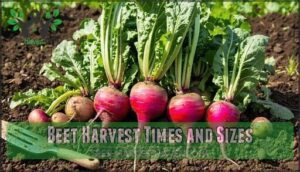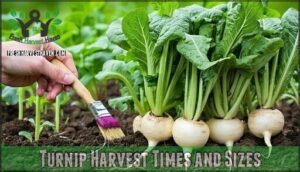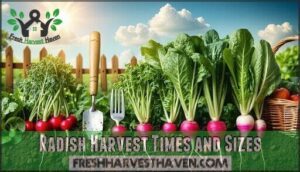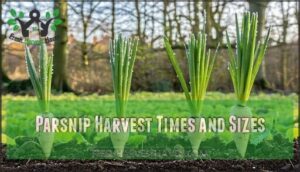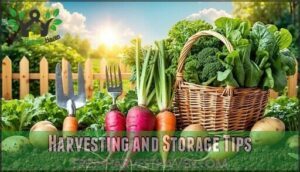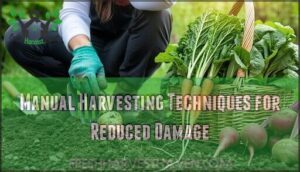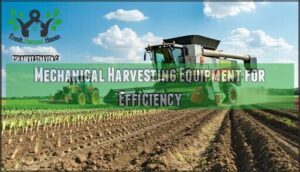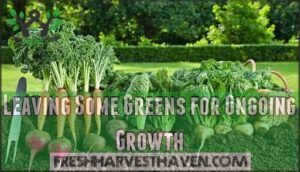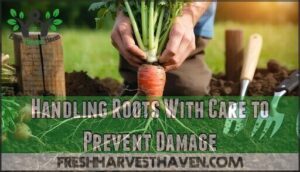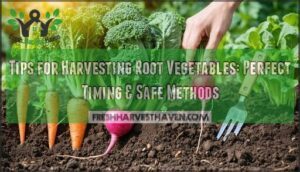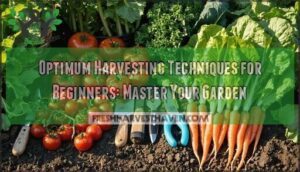This site is supported by our readers. We may earn a commission, at no cost to you, if you purchase through links.
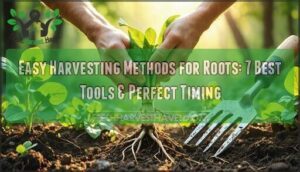 Easy harvesting methods for roots start with timing and technique.
Easy harvesting methods for roots start with timing and technique.
Harvest on dry mornings when soil’s workable but not soggy.
Use a garden fork to gently loosen soil around roots—never yank straight up or you’ll snap them in half.
Grip the greens close to the base and pull steadily upward with consistent pressure.
A Hori Hori knife works wonders for stubborn roots stuck in clay.
Skip the twisting motion that damages tender vegetables.
Brush off excess dirt with your hands, but don’t scrub—you’ll remove protective skin.
The secret lies in reading your soil’s mood and matching your tools to the task, which requires consistent pressure.
Table Of Contents
- Key Takeaways
- Easy Root Harvesting Methods
- Choosing Harvest Time
- 7 Best Tools for Root Harvesting
- Harvesting and Storage Tips
- Effective Harvesting Techniques
- Frequently Asked Questions (FAQs)
- What are the three most common harvesting methods?
- How to harvest roots?
- How to harvest roots without killing plants?
- How are root vegetables harvested?
- How deep should I plant root vegetables?
- What soil type works best for roots?
- Can I harvest roots in wet weather?
- How do I prevent pest damage during harvest?
- Should I wash roots immediately after harvesting?
- Conclusion
Key Takeaways
- Time your harvest for dry mornings – You’ll find roots extract much easier when soil is workable but not soggy, and cool temperatures keep vegetables crisp
- Loosen soil first with a garden fork – Insert the fork 6 inches from the plant and gently work it back and forth to break up compacted soil before pulling
- Pull steadily without twisting – Grip the greens close to the base and use consistent upward pressure instead of jerky motions that’ll snap roots in half
- Match your tools to soil conditions – Use a Hori Hori knife for stubborn clay soil and broadforks for larger areas to make extraction effortless
Easy Root Harvesting Methods
You’ll find harvesting root vegetables much easier when you use the right approach and timing.
The key is loosening soil first, pulling steadily without twisting, and choosing cool morning hours when both you and your vegetables are at their freshest, which makes the process easier with the right approach.
Loosening Soil With Garden Forks
Using a garden fork around your root vegetables breaks up compacted soil without damaging delicate roots.
Insert the fork six inches from the plant and gently work it back and forth. This soil loosening technique creates loose soil that makes root extraction easier.
The digging fork’s tines penetrate deep, preparing the ground for smooth harvesting. Proper soil preparation with garden tools prevents broken roots and guarantees your root harvesting techniques succeed every time.
Effective gardening also involves understanding the right Garden Fork Tool usage for superior results, which is crucial for a successful harvest with minimal damage.
Pulling Roots Steadily With Hori Hori Knives
After loosening soil with your garden fork, you’ll want to pull roots steadily using proper knife techniques.
Sharp steel tines slice through stubborn soil—your roots practically lift themselves from the earth.
A Hori Hori knife excels at root extraction by cutting through stubborn soil around larger roots.
Grip the greens firmly at the base and pull with steady pressure—no twisting motions that damage roots. The knife’s serrated edge helps with gentle harvesting while its pointed tip aids soil loosening.
Clean your root pulling tools between plants for proper tool maintenance.
Many gardeners find the Hori Hori knives invaluable for this task.
Harvesting on Dry, Cool Mornings
When morning dew settles on your garden, you’ll discover the sweet spot for harvesting root vegetables.
Cool temperatures and ideal soil moisture make root extraction easier while preserving vegetable freshness and enhancing root flavor. Cleaning tools prevents contamination and guarantees a healthy harvest.
Morning harvest advantages:
- Morning dew softens soil naturally for easier digging
- Cool air keeps roots crisp and maintains handling ease
- Reduced stress on plants before day’s heat arrives
- Better flavor retention in harvested vegetables
- Improved storage quality from morning’s natural moisture
Choosing Harvest Time
Timing your harvest correctly transforms tough, stubborn roots into easy-to-pull vegetables that practically lift themselves from the soil.
You’ll know each root vegetable is ready when it hits the sweet spot between tender young growth and full maturity—wait too long and you’ll be wrestling with woody, oversized roots that cling to the earth.
Carrot Harvest Times and Sizes
Carrots reach peak harvest readiness when their tops measure ¾ inch thick, typically occurring 70-80 days after planting.
You’ll know it’s time when the shoulder pokes through soil and roots feel firm to touch.
Proper carrot harvest timing guarantees maximum root thickness and carrot quality for your table.
| Harvest Stage | Root Diameter | Days to Maturity |
|---|---|---|
| Baby carrots | ½ inch | 50-60 days |
| Full-size carrots | ¾-1 inch | 70-80 days |
| Storage carrots | 1+ inch | 80-90 days |
Early varieties mature faster, while storage types need extra time for maximum root size development to achieve the best results for your carrot quality.
Beet Harvest Times and Sizes
Beets reach harvest readiness between 50-70 days after planting when they achieve the sweet spot of 1.5 to 3 inches in diameter.
You’ll get the best flavor and tender texture from beets in this size range.
Baby beets can be harvested earlier at 30-40 days for ultra-tender roots, while larger beets work better for long-term storage but may develop woody textures if left too long.
Turnip Harvest Times and Sizes
You’ll harvest turnips when they reach 1-3 inches in diameter, typically 40-60 days after planting.
Turnip maturation happens quickly – some varieties are ready in just 30 days.
Smaller turnips offer sweeter, more tender roots, while larger ones work well for hearty soups.
Check root diameter by gently brushing away soil around the turnip’s shoulders for proper harvest timing.
Understanding turnip growth stages is essential for determining the ideal harvest time and knowing when turnips are ready to be picked at their sweetest and most tender state.
Radish Harvest Times and Sizes
Spring radishes like Cherry Belle zip from seed to harvest in just 20-30 days, reaching that perfect one-inch sweet spot.
Winter varieties like Daikon take their time—up to 60 days—but reward you with massive 15-inch roots.
Don’t let radish timing fool you; these speedy growers turn woody fast if left too long in the ground.
To achieve the best results, understanding radish harvest techniques is essential for gardeners, as it helps in mastering the art of harvest.
Parsnip Harvest Times and Sizes
Parsnip maturity takes patience—these slow growers need 100-120 days from seed to harvest. Your parsnips are ready when they reach 1-2 inches thick and 8-12 inches long.
Patience pays off—parsnips transform winter’s bite into nature’s candy through frost’s sweet alchemy.
The magic happens after frost hits, transforming starches into sugars for that signature sweet flavor.
- Root thickness: Aim for 1-2 inch diameter at the crown
- Harvest timing: Wait until after several moderate freezes
- Frost impact: Cold weather converts starches to natural sugars
- Soil loosening: Use a fork to avoid breaking brittle roots
- Color check: Look for creamy white or pale yellow skin
7 Best Tools for Root Harvesting
Having the right tools makes root harvesting easier and protects your vegetables from damage. These seven essential tools will help you extract roots cleanly while keeping them fresh for storage.
1. Organic Bone Meal Fertilizer Granules
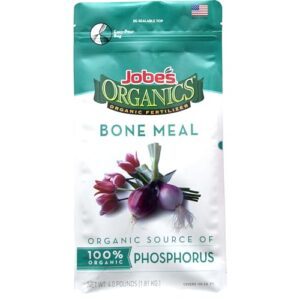
Regularly applying organic bone meal before planting strengthens your root vegetables from the ground up.
This 2-14-0 fertilizer delivers essential phosphorus and calcium that develop robust root systems in carrots, beets, and turnips.
You’ll notice sturdier plants and bigger harvests when you work these OMRI-listed granules into soil every eight weeks.
The dust-free formula makes application simple, while the organic composition keeps your garden chemical-free and safe for families.
Using a balanced soil amendment guide can further enhance the growth and health of your root vegetables.
Best For: Home gardeners seeking a safe, organic fertilizer to boost root vegetables, flowering plants, and bulbs.
- Delivers essential phosphorus and calcium for strong roots and big blooms.
- OMRI-listed and safe for kids, pets, and organic gardens.
- Convenient prilled granules minimize dust and are easy to apply.
- Can be priced higher than other fertilizer brands.
- Overuse may lead to issues like blossom end rot.
- Some users report dustiness if not applied per instructions.
2. Steel Garden Fork with Handle
With a steel garden fork in your hands, you’ll transform root harvesting from a wrestling match into a smooth operation.
The heavy-duty steel tines penetrate compacted soil easily, while the hardwood handle provides comfortable grip during extended use.
Simply insert the fork beside your carrots or beets, gently rock it back and forth to loosen the soil, then lift the roots without damage.
The 4-6 tines create perfect spacing for minimal root breakage, making this tool your reliable partner for clean, efficient harvests.
Best For: Gardeners seeking a versatile, easy-to-control tool for lifting root crops, turning soil, and light composting tasks.
- Sturdy steel tines easily break up compacted or rocky soil without much effort
- Comfortable hardwood handle offers better control and reduces hand fatigue
- Versatile for planting, compost turning, and harvesting root vegetables with minimal damage
- May show instability at the head/handle connection during heavy-duty tasks
- Not recommended for tough landscaping or high-impact yard repairs
- Some users report durability concerns after repeated or intense use
3. Garden Flat Trenching Shovel Tool
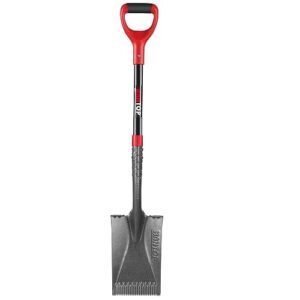
When precision matters most, a flat trenching shovel becomes your secret weapon for delicate root extraction.
This specialized tool features a narrow rectangular blade that slices cleanly through soil without disturbing neighboring plants.
The pointed cutting edge cuts through stubborn root networks while the squared sides create neat trenches around your vegetables.
At just under 30 inches long and weighing less than 2 pounds, you’ll work comfortably for hours.
The sawtooth blade easily penetrates compacted clay soil that often traps larger roots like parsnips and carrots, making it ideal for delicate root extraction and working with compacted clay soil.
Best For: Gardeners or landscapers needing precise trenching or root extraction in tight spaces or compacted soil.
- Sharp, sawtooth blade excels in hard or clay soil.
- Lightweight and comfortable for long sessions, even for shorter users.
- Narrow, squared blade design creates clean, neat trenches with minimal soil disruption.
- Not ideal for moving large volumes of dirt at once.
- Blade size may be limiting for broader digging tasks.
- Handle length may be too short for taller users seeking more leverage.
4. Broad Fork Garden Digging Tool
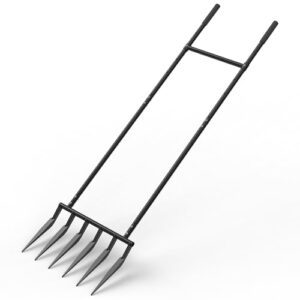
The broadfork transforms root harvesting from back-breaking work into an efficient operation.
This U-shaped tool features 4-6 sharp tines that penetrate soil up to 8 inches deep, loosening compacted earth without disturbing root structure.
You’ll appreciate its 68-inch height and ergonomic rubber handles that eliminate bending.
The heavy-duty steel construction handles rocky terrain while the pedal feature provides extra leverage.
At $99.99, it’s particularly effective in wet soil conditions for farms and raised beds.
Best For: Gardeners and small-scale farmers who need an efficient way to loosen compacted, wet soil in raised beds without straining their backs.
- Not suitable for loose sandy soil or very lightweight users
- Assembly instructions could be clearer, especially for crossbar alignment
- May wobble during heavy use and require extra stabilization
- Cuts easily through rocky and root-filled soil, saving time and effort
- Ergonomic long handles reduce back strain and allow upright work
- Affordable, durable construction with rust-resistant powder coating
5. Fiskars Multi Purpose Garden Knife
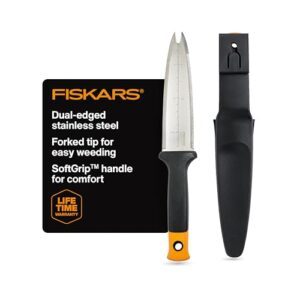
You’ll find this compact knife becomes your go-to tool for precise root harvesting tasks.
The Fiskars Multi Purpose Garden Knife features a dual-edged stainless steel blade with both precision-ground and serrated edges, perfect for cutting through tough soil and thick root systems.
Its forked tip efficiently removes stubborn weeds and taproots while integrated measurements help gauge planting depth.
The ergonomic SoftGrip handle reduces hand fatigue during extended use, and the corrosion-resistant construction guarantees long-lasting durability for reliable garden work.
Best For: Gardeners seeking a versatile, easy-to-use tool for weeding, planting, and precision digging tasks.
- Sheath may break if used frequently on a belt
- Not designed for heavy-duty digging in very rocky soil
- Some users may prefer a larger blade for big root systems
- Dual-edged stainless steel blade quickly handles both slicing and sawing jobs
- Ergonomic SoftGrip handle reduces hand fatigue during long projects
- Built-in measurement markings improve accuracy when planting or harvesting
6. Garden Harvest Basket with Caddy
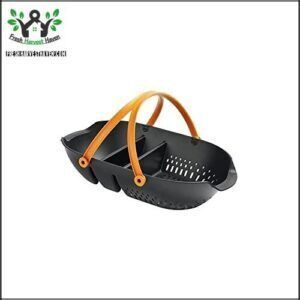
Why settle for multiple trips when you can carry everything in one go?
The Fiskars Garden Harvest Basket doubles as your collection and cleaning station. Its dual-sided design separates dirty roots on the colander side from clean produce on the enclosed side.
You’ll love the ergonomic handles that interlock for one-handed carrying when your other hand’s busy. This durable plastic basket holds large harvests while letting you rinse vegetables right in the garden.
It’s like having a portable sink that follows you around.
Best For: Medium to large home gardeners who want to collect, wash, and transport harvests in one sturdy basket.
- Multi-functional design lets you collect and wash produce in the same basket.
- Ergonomic handles for comfortable one- or two-handed carrying.
- Durable plastic construction comes with a lifetime warranty.
- Large size may be awkward for small gardens or light harvests.
- Handles do not snap shut, only mold together for a single-handle grip.
- Some users find the price high compared to simpler or traditional baskets.
7. Leather Work Gloves for Gardening

When handling root vegetables, you’ll want protection that won’t let you down.
Quality leather work gloves shield your hands from thorns, cuts, and punctures while maintaining excellent dexterity.
Made from durable cowhide or pigskin, these gloves resist tears and provide reliable grip during harvesting.
Their reinforced palms handle rough root surfaces and soil debris.
Choose breathable designs with adjustable wrist straps for comfort during extended garden sessions.
Proper gloves mean confident harvesting without worrying about scraped knuckles or embedded thorns, ensuring reliable grip and protection.
Best For: Gardeners, landscapers, and anyone needing tough, thorn-proof gloves for rugged outdoor and indoor tasks.
- Excellent protection against thorns, cuts, and punctures
- Durable and long-lasting even with heavy use
- Adjustable fit and breathable lining for comfort
- Requires maintenance and more cleaning effort than synthetic gloves
- Some users may need to order one size up for a proper fit
- Can be less flexible than lightweight fabric alternatives
Harvesting and Storage Tips
Once you’ve harvested your root vegetables, proper storage techniques will keep them fresh for months. The key is understanding each vegetable’s specific storage needs and recognizing quality indicators before storing.
Storage Methods for Beets and Carrots
After you’ve gathered your fresh beet harvest and carrot greens, proper storage keeps them crisp for weeks.
Cool storage in humid conditions preserves quality while root cellars provide ideal environments for fresh keeping.
- Beets: Store unwashed in the crisper drawer with 2 inches of stem attached to prevent color bleeding
- Carrots: Layer in moist sand in vegetable crates or use damp paper towels in refrigerator bags
- Root Cellars: Maintain 32-40°F temperatures with 90-95% humidity for superior root vegetable storage
- Fresh Keeping: Leave soil on roots and avoid washing until ready to use for extended vegetable storage methods
Storage Methods for Turnips and Radishes
Store turnips and radishes in cool, humid conditions to maintain their crisp texture and fresh flavor.
Root cellars provide ideal storage environments with temperatures around 35°F and high humidity levels.
You can also refrigerate these root vegetables in perforated bags or wrap them in damp cloths.
Fresh handling during harvest timing guarantees better storage life for your turnip harvest and radish roots, ensuring a longer storage life.
Storage Methods for Parsnips
Parsnips thrive in cool, dry storage conditions after their post-frost harvest. You’ll want to brush off excess soil but leave roots unwashed to maintain their natural protective coating.
Root cellars provide ideal conditions with temperatures around 35°F and controlled humidity levels that prevent moisture loss while avoiding rot.
Storage methods for best parsnip preservation:
- Root cellar magic – Creates the perfect 35°F environment where your parsnips stay fresh for months like nature’s own refrigerator
- Layered sand storage – Nestle roots in damp sand inside wooden crates, mimicking their underground home for extended freshness
- Freeze options – Blanch and freeze parsnips for year-round cooking convenience when fresh storage isn’t possible
- Humidity control systems – Maintain 90-95% humidity using perforated bags or damp cloths to prevent shriveling and maintain crisp texture
Visual Cues for Ripeness and Quality
Look for bright, uniform colors that signal peak ripeness. Carrots show vibrant orange hues, while beets display deep red or golden tones.
Check for smooth, unblemished skin without cracks or splits. Size variations matter – medium-sized roots typically offer the best flavor.
Fresh, green tops indicate healthy growth patterns, while yellowing leaves suggest maturity for harvest timing. The presence of these characteristics can help determine if the roots have reached optimal ripeness.
Tactile Cues for Freshness and Texture
Your hands tell the story before your eyes do. Fresh roots feel firm and dense when you gently squeeze them, while old vegetables give way under pressure. Root texture reveals quality instantly through these tactile cues.
- Firmness Test: Press gently – fresh roots resist compression and feel solid throughout
- Skin Smoothness Check: Run fingers along the surface – quality vegetables have taut, unblemished skin
- Weight Assessment: Compare similar-sized roots – denser vegetables indicate better flavor development and freshness
Effective Harvesting Techniques
You’ll achieve better harvests when you use the right techniques for your specific root vegetables.
The method you choose—whether manual or mechanical—directly impacts both the quality of your roots and how much damage occurs during harvest, which is why choosing the right method is crucial for the quality of your roots.
Manual Harvesting Techniques for Reduced Damage
Hand-harvesting saves roots by reducing damage through gentle soil loosening and careful root extraction.
Start by loosening soil around plants using a digging fork, then pull roots steadily without twisting.
Tool sterilization prevents disease spread between plants.
Proper harvest timing guarantees easy root extraction when vegetables reach ideal size.
Manual tools offer precise control, making gentle handling possible for delicate root systems, which is crucial for delicate root systems and allows for gentle soil loosening.
Mechanical Harvesting Equipment for Efficiency
Mechanical harvesters revolutionize your root crop operations, boosting efficiency by 300-500% compared to manual methods.
Tractor attachments with crop sensors automatically adjust digging depth, while automation tools reduce labor costs by 70%.
Modern harvest machines feature conveyor systems and hydraulic lifts for seamless collection.
Consider walkbehind tractors with broadfork attachments for smaller plots, or invest in motorized helpers with middle buster plow capabilities for precision harvesting techniques.
The use of a Root Harvester machine can substantially improve crop yields and reduce waste, making it a valuable tool for root crop operations.
Early Harvesting for Tender Roots and Greens
You’ll capture the sweetest flavors when you harvest tender roots early in their development cycle.
Early picking lets you enjoy both leafy greens and baby roots from the same plant.
Most root vegetables develop their best texture during early morning harvesting when moisture levels peak.
This technique maximizes your green harvest while encouraging continued root development for future pickings, allowing for a more efficient and sustainable gardening practice.
Leaving Some Greens for Ongoing Growth
When you harvest cutandcomeagain crops like leafy greens, leave some green tops on your root vegetables for ongoing growth.
This leaf management technique promotes greens regrowth while supporting root development beneath the soil.
Stem thickness serves as foliar indicators – thicker stems signal larger roots below.
This easy harvesting approach maximizes your harvest from root crop harvesting by allowing continuous leaf production alongside root growth.
Effective harvesting techniques involve understanding proper harvesting times to guarantee the best results, using proper harvesting times and effective harvesting techniques.
Handling Roots With Care to Prevent Damage
Gentle handling keeps your harvest intact and delicious.
Use steady, firm pressure when pulling—jerky movements snap brittle roots in half.
Loosen soil first with sterilized tools to prevent root damage prevention.
Support the entire root while extracting to avoid breaking.
Clean your root digging tools between plants to stop disease spread.
These root extraction methods guarantee perfect root vegetable harvesting every time.
Frequently Asked Questions (FAQs)
What are the three most common harvesting methods?
Manual harvesting reduces root damage by 30% compared to mechanical methods.
You’ll use three main techniques: hand-pulling for small roots like radishes, fork-loosening for carrots and beets, then gentle extraction by grasping greens firmly.
This technique is beneficial for the roots as it reduces damage and allows for gentle extraction.
How to harvest roots?
First, water the soil to soften it.
Use a garden fork to gently loosen dirt around roots.
Grasp greens firmly at the base, then pull steadily upward without twisting to avoid breaking roots.
How to harvest roots without killing plants?
Use selective harvesting—pull only the largest roots while leaving smaller ones intact.
Loosen soil gently with a fork, then pull by the greens without twisting to avoid damaging neighboring plants.
How are root vegetables harvested?
Like unearthing buried treasure, you’ll gently loosen soil with a fork, then pull roots by their greens using steady pressure—never twist or yank to avoid breaking your precious harvest.
How deep should I plant root vegetables?
Plant root vegetables’ seeds at depths two to three times their diameter. You’ll need shallow planting for radishes and carrots, deeper placement for parsnips and turnips to guarantee proper development.
What soil type works best for roots?
Well-drained, loose soil acts like a welcome mat for your roots. Sandy loam with good drainage and organic matter creates the perfect foundation for healthy growth and easy harvesting.
Can I harvest roots in wet weather?
You shouldn’t harvest roots in wet weather because wet soil makes extraction difficult and damages delicate roots. Wait for dry conditions – you’ll get cleaner roots with less breakage.
How do I prevent pest damage during harvest?
Clean tools with alcohol, harvest on dry mornings, inspect roots for damage before storing, and remove any pest-infested vegetables immediately to prevent spread.
Should I wash roots immediately after harvesting?
No, don’t wash roots immediately after harvesting.
Leave the dirt on to keep them fresh longer during storage.
The soil acts as natural protection, preventing moisture loss and extending shelf life substantially.
Conclusion
Mastering these easy harvesting methods for roots transforms your garden into a treasure chest of fresh vegetables.
You’ll discover that proper timing and gentle techniques preserve both flavor and storage life.
Remember to work with dry soil, use steady pressure instead of jerky motions, and match your tools to soil conditions.
Your garden fork and Hori Hori knife will become trusted partners in this rewarding process, with practice you’ll harvest perfect roots every time.
- https://victoryseeds.com/?utm_source=garden.org&utm_medium=web&utm_campaign=nga_article_footer
- http://www.sparkpeople.com/resource/nutrition_articles.asp?id=1293
- http://survivalathome.com/10-easy-garden-crops/
- http://www.mybalconyjungle.com/root_crops.html
- https://www.ufseeds.com/turnip-seed-to-harvest.html?srsltid=AfmBOoo7qwRv45wUuBL9LCqSWEQ27M9REDf4bBQyiTiWiiAUxg4AxcBv


